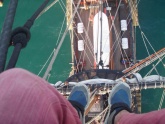OK, so I get the tactical details of beating upwind--you go as close as you can to the wind in one direction, then tack and go as close to the wind in the other direction, thus overall moving you "forward" in a big zigzag. Since these ships can't get very close to the wind, it's a laborious process, because you do a lot of side motion for each small increment of forward motion.
My question is: what did this mean on a larger scale of voyages and campaigns?
1) For example, how long would the legs be? If a ship was trying to go somewhere that was "into the wind," how long would they sail on one tack before shifting? (or to put it another way, how often would they have to tack per day?)
2) Was this basically a straight-forward thing to do, or did it involve serious risks, wear & tear, crew fatigue, etc.?
3) I've read in books things like "well we were lucky the winds were against them, so they couldn't sortie while out squadron was dispersed" or something like that. If they could beat upwind, why couldn't they sortie? It doesn't seem to be a function only of very specific port configurations (although sometimes that seems to be the issue). So more generally--was this something a ship could do, but a fleet couldn't really? Or did ships/fleets only beat upwind for long periods under extraordinary circumstances? And if so, why? Because... it was so slow? you'd use up all your supplies? it was too risky?
Just trying to get a better handle on the strategic considerations captains and admirals faced...






 Reply With Quote
Reply With Quote





Bookmarks